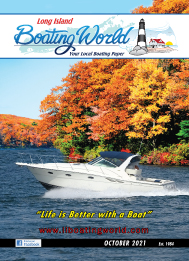
Handling a Powerboat … It is Better to be Safe than Sorry !!! The skills required to safely handle a powerboat go far beyond those included in boating safety courses. A proficient Skipper must keep one step ahead and take the time to fully understand how to balance the varying forces encountered at sea while underway. Once mastered, these handling skills need to become an instinctive reaction to whatever forces act against the vessel. This boating safety tip outlines the basic principles and practices used by the Skipper or Helmsman who needs to maintain control over the mitigating forces they have under their control (power, steering, maneuvering). In addition, these same Skippers need to be proficient at quickly reacting to the forces they encounter that they don’t have control over (wind, waves, etc.).
Forces that Impact a Vessel … 1. Environmental Forces … These influence the motion and direction of a vessel. The primary actors are wind, sea conditions, and current. The Skipper doesn’t control these forces but he or she needs to recognize what environmental conditions are developing, and how to react. This requires the knowledge to quickly identify changing conditions which impact approaching weather fronts that negatively or positively impact the wind, seas, and currents. 2. Using Forces to Gain an Advantage … Some forces can be used as an advantage. Examples of when environmental forces that can be used to an advantage are mooring, anchoring and docking. In these cases the Skipper will approach the target going into the wind. 3. Using Tools to Overcome Forces … Experienced Skippers are proficient at using tools to overcome forces. Good examples are propulsion and steering. Just as you would use your accelerator and steering wheel when in a car, the Skipper can use the throttle and helm to advance, turn, and slow the boat. At times, an anchor becomes the tool that holds the boat in place when it has lost power. A spring line is also a tool that is used to assist when docking or leaving a dock. Maneuvering and Operations … 4. The Impact of Currents … Current is a force that impacts sea conditions when paired with an opposing wind. The result is waves that become steeper and rougher. When this occurs, an alert Skipper or helmsman, will become extra cautious. This is because the waters atop an approaching bar will begin to break. Such an event presents a unique challenge to crew members who are manning the helm. Another challenge currents present is the possibility of overshooting the landing. Helm Techniques … A vessel’s Skipper needs to know how his or her vessel will respond to the different combinations of wind and currents. With this knowledge they will be able to determine which solution has the greatest impact on the vessel’s present handling conditions, and how to combat any negative results. It may be that up to a certain wind speed, the current has more control over a given vessel. However, above that wind speed, the boat may become harder to control. For instance, the Skipper should know what will happen if a sudden gust of wind is encountered; will the boat immediately veer, or will it take a stronger gust to start it turning? A different force is created when current goes against the wind. In this case the wave patterns will become steeper and closer together. The Skipper should be particularly cautious where current or wind are acting against one another. Two examples are rip tides, and breaking bars. On the other hand, making leeway while drifting down current requires a change in your approach to avoid overshooting the dock. Propulsion Forces … 5. Single Engine Boats … a single-engine boat will have motor and driveshaft mounted along the vessel’s center line. When moving forward, the force of the propellor will push the stern to port. When backing it will push the stern to starboard. These forces must be compensated for by the rudder. 6. Twin Engine Boats … In a twin engine configuration the propellers spin in opposing directions. The starboard propeller will spin clockwise, while the port unit will spin counterclockwise. These opposing spins have the effect of cancelling each propeller’s tendency to alter the vessels heading. The result is less helm adjustments are needed to proceed in a straight line. Direction Control … 7. The Ship’s Compass … The ship’s compass is a tool used to keep the vessel on the intended course. It is important that the person at the helm has the skill needed to accurately steer a straight course. The key for mastering this skill is to use small, early helm corrections as needed to compensate for wind and current forces. Success is achieved when the Helmsman avoids oversteering. Appropriate Speed … 8. Excessive Speed Wastes Fuel, Causes Excessive Wear on the Boat, and Results in Crew Fatigue … Finding a speed that offers a comfortable ride enhances the Skipper’s ability to provide a good experience for all aboard … Smart Boating is Safe Boating !!!
